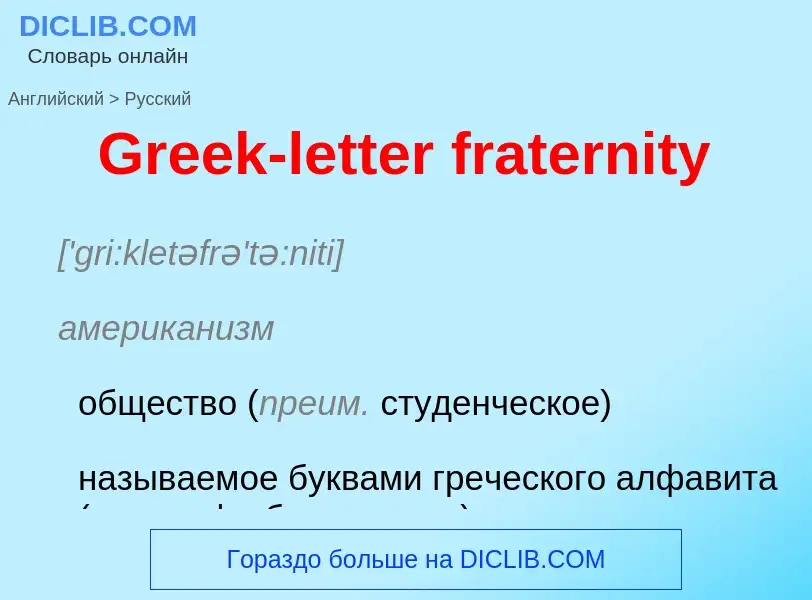Перевод и анализ слов искусственным интеллектом ChatGPT
На этой странице Вы можете получить подробный анализ слова или словосочетания, произведенный с помощью лучшей на сегодняшний день технологии искусственного интеллекта:
- как употребляется слово
- частота употребления
- используется оно чаще в устной или письменной речи
- варианты перевода слова
- примеры употребления (несколько фраз с переводом)
- этимология
Greek-letter fraternity - перевод на русский
['gri:kletəfrə'tə:niti]
американизм
общество (преим. студенческое)
называемое буквами греческого алфавита (напр. «фи бета каппа»)
[sə'rɔriti]
существительное
общая лексика
женская организация
женское общество
женская община
женское землячество (в университете и т. п.)
американизм
университетский женский клуб
Определение
Википедия
Phi (; uppercase Φ, lowercase φ or ϕ; Ancient Greek: ϕεῖ pheî [pʰéî̯]; Modern Greek: φι fi [fi]) is the 21st letter of the Greek alphabet.
In Archaic and Classical Greek (c. 9th century BC to 4th century BC), it represented an aspirated voiceless bilabial plosive ([pʰ]), which was the origin of its usual romanization as ⟨ph⟩. During the later part of Classical Antiquity, in Koine Greek (c. 4th century BC to 4th century AD), its pronunciation shifted to that of a voiceless bilabial fricative ([ɸ]), and by the Byzantine Greek period (c. 4th century AD to 15th century AD) it developed its modern pronunciation as a voiceless labiodental fricative ([f]). The romanization of the Modern Greek phoneme is therefore usually ⟨f⟩.
It may be that phi originated as the letter qoppa (Ϙ, ϙ), and initially represented the sound /kʷʰ/ before shifting to Classical Greek [pʰ]. In traditional Greek numerals, phi has a value of 500 (φʹ) or 500,000 (͵φ). The Cyrillic letter Ef (Ф, ф) descends from phi.
As with other Greek letters, lowercase phi (encoded as the Unicode character U+03C6 φ GREEK SMALL LETTER PHI) is used as a mathematical or scientific symbol. Some uses, such as the golden ratio, require the old-fashioned 'closed' glyph, which is separately encoded as the Unicode character U+03D5 ϕ GREEK PHI SYMBOL.


![The [[Alpha Delta Phi]] house at [[Cornell University]] in [[Ithaca, New York]] The [[Alpha Delta Phi]] house at [[Cornell University]] in [[Ithaca, New York]]](https://commons.wikimedia.org/wiki/Special:FilePath/Adphicornell.jpg?width=200)
![The [[Alpha Sigma Phi]] house at the [[University of Illinois Urbana-Champaign]] The [[Alpha Sigma Phi]] house at the [[University of Illinois Urbana-Champaign]]](https://commons.wikimedia.org/wiki/Special:FilePath/AlphaSigmaPhiUIUC.jpg?width=200)
![[[Ronald Reagan]] was initiated into [[Tau Kappa Epsilon]] at [[Eureka College]] in [[Eureka, Illinois]] and [[George H. W. Bush]] was a member of [[Delta Kappa Epsilon]] at [[Yale University]]. [[Ronald Reagan]] was initiated into [[Tau Kappa Epsilon]] at [[Eureka College]] in [[Eureka, Illinois]] and [[George H. W. Bush]] was a member of [[Delta Kappa Epsilon]] at [[Yale University]].](https://commons.wikimedia.org/wiki/Special:FilePath/Bush reagan.jpg?width=200)
![An illustration depicting fraternity [[hazing]] from the early 20th century An illustration depicting fraternity [[hazing]] from the early 20th century](https://commons.wikimedia.org/wiki/Special:FilePath/Flying Machine.jpg?width=200)
![The [[Kappa Kappa Gamma]] house at the [[University of Illinois at Urbana–Champaign]] The [[Kappa Kappa Gamma]] house at the [[University of Illinois at Urbana–Champaign]]](https://commons.wikimedia.org/wiki/Special:FilePath/KappaKappaGammaSororityHouse Urbana Illinois 4419.jpg?width=200)
![Members of [[Phi Kappa Sigma]] at [[Washington & Jefferson College]] in [[Washington, Pennsylvania]] in 1872 Members of [[Phi Kappa Sigma]] at [[Washington & Jefferson College]] in [[Washington, Pennsylvania]] in 1872](https://commons.wikimedia.org/wiki/Special:FilePath/Phi Kappa Sigma 1872 W&J College.jpg?width=200)
![The fraternity system in North America began at the [[College of William and Mary]] in [[Williamsburg, Virginia]], where [[Phi Beta Kappa]] was founded in 1775. The fraternity system in North America began at the [[College of William and Mary]] in [[Williamsburg, Virginia]], where [[Phi Beta Kappa]] was founded in 1775.](https://commons.wikimedia.org/wiki/Special:FilePath/Rear view of the Wren Building, College of William & Mary in Williamsburg, Virginia, USA (2008-04-23).jpg?width=200)
![U.S. Air Force]] airmen, presumably members of [[Sigma Phi Epsilon]], display that fraternity's flag in [[Iraq]] in 2009. U.S. Air Force]] airmen, presumably members of [[Sigma Phi Epsilon]], display that fraternity's flag in [[Iraq]] in 2009.](https://commons.wikimedia.org/wiki/Special:FilePath/SigEpFlagIraq.jpg?width=200)
![Members of [[Sigma Chi]] at [[Miami University]] in [[Oxford, Ohio]], including founders [[Benjamin Piatt Runkle]] and Daniel William Cooper and an unidentified woman at a 1909 reunion Members of [[Sigma Chi]] at [[Miami University]] in [[Oxford, Ohio]], including founders [[Benjamin Piatt Runkle]] and Daniel William Cooper and an unidentified woman at a 1909 reunion](https://commons.wikimedia.org/wiki/Special:FilePath/Sigma Chi fraternity reunion group portrait 1909 (3194715451).jpg?width=200)
![A model chapter room of [[Kappa Sigma]] A model chapter room of [[Kappa Sigma]]](https://commons.wikimedia.org/wiki/Special:FilePath/The Model Chapter Room (526839509).jpg?width=200)
![George Floyd protest]] in [[Atlanta]] in June 2020 George Floyd protest]] in [[Atlanta]] in June 2020](https://commons.wikimedia.org/wiki/Special:FilePath/U.S. Airmen and Soldiers from the Georgia National Guard assists law enforcement agencies during protests in Atlanta.jpg?width=200)
![[[Wesleyan College]] in [[Macon, Georgia]], pictured c. 1877, was the birthplace of [[Alpha Delta Pi]] and [[Phi Mu]] sororities [[Wesleyan College]] in [[Macon, Georgia]], pictured c. 1877, was the birthplace of [[Alpha Delta Pi]] and [[Phi Mu]] sororities](https://commons.wikimedia.org/wiki/Special:FilePath/Wesleyan College, circa 1877 - DPLA - 6098fed0d90914d03c98118db843e638.jpg?width=200)
